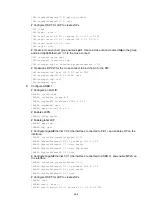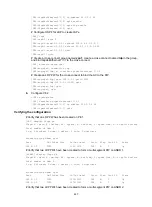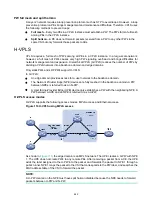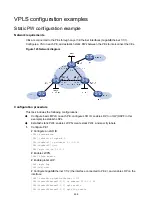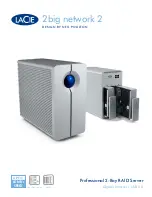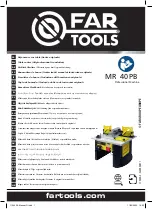
442
PW full mesh and split horizon
A Layer 2 network requires a loop prevention protocol such as STP to avoid loops. However, a loop
prevention protocol on PEs brings management and maintenance difficulties. Therefore, VPLS uses
the following methods to prevent loops:
•
Full
mesh
—Every two PEs in a VPLS instance must establish a PW. The PWs form a full mesh
among PEs in the VPLS instance.
•
Split
horizon
—A PE does not forward packets received from a PW to any other PWs in the
same VSI but only forwards those packets to ACs.
H-VPLS
VPLS requires a full mesh of PWs among all PEs in a VPLS instance. In a large-scale network,
however, a full mesh of PWs causes very high PW signaling overhead and brings difficulties for
network management and expansion. Hierarchical VPLS (H-VPLS) reduces the number of PWs by
dividing a VPLS network into a backbone domain and edge domains.
Only static PWs and LDP PWs support H-VPLS.
In H-VPLS:
•
An edge domain provides access for a user network to the backbone domain.
•
The Network Provider Edge (NPE) devices are fully meshed in the backbone domain. A PW
between NPEs is referred to as an N-PW.
•
A User facing-Provider Edge (UPE) device only establishes a PW with the neighboring NPE. A
PW between a UPE and an NPE is referred to as a U-PW.
H-VPLS access modes
H-VPLS supports the following access modes: MPLS access and Ethernet access.
Figure 119 H-VPLS using MPLS access
As shown in
, the edge domain is an MPLS network. The UPE creates a U-PW with NPE
1. The UPE does not create PWs to any remote PEs. After receiving a packet from a CE, the UPE
adds the label assigned to the U-PW into the packet and forwards the packet to NPE 1 through a
public tunnel. NPE 1 maps the packet to the VSI that corresponds to the PW label, and searches the
MAC address table of the VSI to forward the packet.
NOTE:
A U-PW created on the NPE must have split horizon disabled because the NPE needs to forward
packets between U-PW and N-PW.







